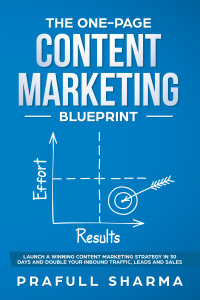5 Steps to Building a Killer Content Machine
The content creation conundrum has two versions that have the same outcome.
One version involves marketers with extremely lean teams. They don’t have enough resources and as a result, they’re not churning out the volume of content they want.
The second version involves businesses that have considerable number of staff. Some may even have a dedicated content marketing team. However, they still fail to produce content as often as they would like.
If it’s not about the size of your team, what gives?
While the size of your team has an impact on the quantity and quality of content that you produce, it’s not the determining factor. In fact, there are small teams out there that are outperforming bigger companies in content marketing.
The biggest success factor in content marketing is the quality of your content machine.
Of course, this is not an actual hardware or technology that produces content. It’s the strategy, processes, and systems that you use to give every content piece that you produce the maximum reach and leverage. It also enables you to produce a wealth of content in the least amount of time.
Not only that, an efficient content marketing machine allows you to produce content that drives positive business results.
Here are the 5 steps to build a quality content machine for your business:
1. Create a Content Culture
A content culture sounds like an extremely abstract idea, but it’s the very first — and important — step in building an effective and efficient content machine.
A well-oiled and well-run content machine is composed of solid, high-quality elements that are all working together to achieve the same objective. To create a content machine, foster a company culture that supports the goal of consistent, high-quality content development.
Many companies produce content because they read somewhere that it’s necessary, without understanding the why behind it. As a result, content becomes a fluffy afterthought.
On the contrary, a business with a strong content culture knows the value of great content — both to the business and to their audience. Creating high-quality content that helps people solve problems and adds real value to people’s lives is a priority, rather than just a best practice that needs to be followed.
2. Define Your Content Avatar/s
Creating content avatars are the first concrete step in creating a killer content machine for your business. In order for any piece of content to have a purpose, you need to know who you’re writing for.
If you already have customer avatars for your products/services, you can repurpose these profiles to create your content avatars. If not, below are the basic elements of clearly defined content avatars:
- Enumerate their pain points
- Know their motivations
- Outline their goals and desires
- Identity the challenges preventing them from achieving their desired result
- What media channels are they present in?
- Who are the people that influence their decisions?
Additionally, part of defining your content avatars is knowing which stage they are in the buyer’s journey:
- Are they aware that they have a problem?
- Do they know the available solutions?
- Are they aware of your products/services?
- Are they comparing solutions from different providers?
- Are they ready to take action and make a purchase?
Clearly defined customer avatars will allow your content machine to zero in on the audience segment that matters most to your business.
3. Create and Organize a Laundry List of Content Ideas Into a Calendar
The funny thing about content marketers is the more they think about producing high-quality content, the more they get stuck. Perfectionism kicks in and they become too conscious whether their ideas will take off or not.
The reality is there’s no way of knowing with 100% certainty whether a content idea will perform well or not during this stage. In fact, the only time you know whether your idea is good or bad is when you’ve already published and received audience feedback.
The best practice is using your available tools to create a laundry list of content ideas targeted to the different customer avatars you created. At this stage, as long as there is enough material to support your concept, and as long as it is logically sound, there is no such thing as a bad idea.
Organize these ideas into a content calendar or an editorial worksheet. Share this with your team and let collaboration bring these ideas to life.
4. Put Together a Content Creation Assembly Line
The content assembly line makes up the biggest chunk of your content machine. This is the machine itself. You need to ensure that this machine has all the necessary parts to function well.
For the most basic content creation assembly line, include the following personnel:
- A researcher and writer who will find more information on a topic and execute the content itself
- A proofreader who will check the content for grammatical and spelling errors
- A marketing editor who will check the different marketing aspects of an article such as SEO compliance and if it’s aligned with the content avatar
- A multimedia specialist who will source visual assets such as images and videos that will go together with the articles
- A CMS personnel who will publish the post on your blog platform (i.e. WordPress)
- A marketing specialist who will promote your content in social media and other relevant channels
There are 6 roles listed here, but it doesn’t mean hiring 6 team members to fulfill these tasks. One team member can fulfill different roles. In short, having a small team is not an excuse for you to not be able to build an efficient content machine.
Pro tip: If you believe you need more hands on deck in order to build your own killer content machine but you’re strapped on cash for additional employees, consider outsourcing your content requirements to an agency. Ask them to tailor fit their services depending on your needs and budget.
5. Repurpose Your Content
You don’t always have to reinvent the wheel every time you create content — repeatedly starting from scratch. Businesses with well-run content machines harness the power of content amplifiers to extend the reach of their content without having to go through the process of coming up with new ideas and researching for materials.
For example, a long-form blog post can be transformed into other content formats such as:
- Slideshares
- Infographics
- Short how-to videos
- Short-form posts
- Ebooks
- Checklists
- Email content
You can use different distribution channels to maximize the reach of your content. Likewise, when coming up with new ideas for content, prioritize ideas that can be repurposed.
6. Start Building Your Content Machine Today
Good content produces good returns, which is why creating a killer content machine is important to enable you to produce quality content regularly and consistently. Once again, you don’t need a 10-man team to be successful at it, but putting good systems and processes in place is essential.
If you don’t have a content machine yet, the important thing is to get started as soon as possible. Start by incorporating content in your company culture. By coming up with one content idea every day, you will develop a well-functioning content machine in no time.
However, if you want to outsource your content marketing needs to an agency that already has a proven content marketing machine in place, feel free to reach out to us. We can tailor fit our services to fit your needs and budget.
In the meantime, if you found this content useful, do us a favor and share it on social media. If you have successfully built your own content machine, we’d love to know how you did it. Drop us a note in the comments section below.
Share This Story
3 Comments
Leave A Comment
Get the latest growth ideas, strategies, and best practices delivered to your inbox.
Quick read that helps 7000+ subscribers.










[…] Content is a critical part of marketing. Institutions, large or small, have since recognized that online presence is important to their growth and continued relevance among their target audience. And a big part of that online presence is dependent on the kind of content that they produce. […]
[…] is not to say there aren’t some effective benchmarks and best practices that you can use right now, however. Here are some of my top recommended strategies that work […]
Insightful breakdown of what it really takes to build a sustainable content engine. As we review SaaS and marketing tools, we often see how strong processes and content systems make the biggest difference, especially for lean teams aiming to scale efficiently.